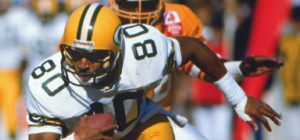Yesterday, we looked at which quarterbacks were the best at yards per completion after adjusting for league average. Today, we’ll do the same thing for wide receivers and yards per completion.
A small tweak is necessary to the formula. You can skip down to the results section if you don’t care about the math, but I suppose most of my readers want to know what goes in the sausage. We can’t just use league-wide yards per completion rates, since that average includes receptions by non-wide receivers. One way around this is to calculate the league average YPC for wide receivers only; that’s easy to do for 2013, but less easy to do for the earlier years of NFL history when the distinction among the positions was not so clear. So, after playing around with a few different methods, I’ve decided to instead use 120% of the league average YPC rate, and give wide receivers credit for their yards over expectation using that inflated number.For example, in 1983, James Lofton caught 58 passes for 1,300 yards for the Packers, a 22.4 YPC average. That year, the average reception went for 12.63 yards; 120% of that average is 15.2, which means we would give Lofton credit only for his yards over the product of 15.2 and 58, or 879. Since Lofton actually had 1,300 yards, he gets credit for 421 yards over expectation.
The next year, Lofton caught 62 passes for 1,361 yards (22.0). Since the average reception went for 12.66 yards, Lofton gets credit for his yards over (120% * 12.66 * 62), or 942. Lofton therefore is credited with 419 yards over expectation, nearly identical to his performance in the prior year. In fact, those were the 10th and 11th best season in NFL history by this method.
The Results
Here’s a list of the top 200 single-season performers.
Calculate these grades for every season of each wide receiver’s career, and you get the following career numbers. Here’s how to read Lofton’s line, who checks in at number one. He played from 1978 to 1993, and for his career, caught 764 passes for 14,004 yards, an 18.33 YPC average. Based on 120% of the league average YPC rate in each year, this means Lofton exceeded his expected number of yards (based on his receptions) by 2,502 yards, the most in NFL history. Stanley Morgan, the man who propelled Steve Grogan to the top of yesterday’s list, comes in at number two. The rest of the top five isn’t a surprise: Henry Ellard and Randy Moss were legendary deep threats, and we all know about Paul Warfield and his unique career. Homer Jones, who ranks 1st in average length of receiving touchdown, checks in at #14.
Because of the way the formula works, a list of the worst receivers in this metric would be a bunch of running backs. So instead, I’ll close with a list of the 100 players with the most receptions in NFL history, and their ranks according to this formula:
A couple of wide receivers stand out with negative grades, and there are no surprises here. Wes Welker, Cris Carter, Hines Ward, Raymond Berry, T.J. Houshmandzadeh, Art Monk, Troy Brown, etc., made their livings as possession receivers. Yards per completion, like yards per catch, is not so much a reflection of ability as it is of style. And there’s nothing wrong with that.

